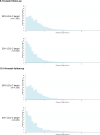Low-density lipoprotein-cholesterol target attainment according to the 2011 and 2016 ESC/EAS dyslipidaemia guidelines in patients with a recent myocardial infarction: nationwide cohort study, 2013-17
- PMID: 32142112
- PMCID: PMC7834860
- DOI: 10.1093/ehjqcco/qcaa016
Low-density lipoprotein-cholesterol target attainment according to the 2011 and 2016 ESC/EAS dyslipidaemia guidelines in patients with a recent myocardial infarction: nationwide cohort study, 2013-17
Abstract
Aims: To assess low-density lipoprotein cholesterol (LDL-C) treatment target attainment among myocardial infarction (MI) patients according to the European Society of Cardiology (ESC)/European Atherosclerosis Society (EAS) dyslipidaemia guidelines from 2011 (LDL-C < 1.8 mmol/L or ≥50% LDL-C reduction) and 2016 (LDL-C < 1.8 mmol/L and ≥50% LDL-C reduction).
Methods and results: Using nationwide registers, we identified 44 890 patients aged 21-74 admitted for MI, 2013-17. We included those attending follow-up visits at 6-10 weeks (n = 25 466) and 12-14 months (n = 17 117) after the event. Most patients received high-intensity statin monotherapy [84.3% (6-10 weeks) and 69.0% (12-14 months)] or statins with ezetimibe (2.7% and 10.2%). The proportion of patients attaining the 2011 LDL-C target was 63.8% (6-10 weeks) and 63.5% (12-14 months). The corresponding numbers for the 2016 LDL-C target were 31.6% (6-10 weeks) and 31.5% (12-14 months). At the 6- to 10-week follow-up, 37% of those not attaining the 2011 LDL-C target and 48% of those not attaining the 2016 target had an LDL-C level that was ≥0.5 mmol/L from the target. When comparing LDL-C measurements performed before vs. after the release of the 2016 guidelines, attainment of the 2016 LDL-C target increased from 30.2% to 35.0% (6-10 weeks) and from 27.6% to 37.6% (12-14 months).
Conclusion: In a nationwide register, one out of three patients with a recent MI had not attained the LDL-C target of the 2011 ESC/EAS guidelines and two out of three patients had not attained the LDL-C target of the 2016 guidelines.
Keywords: Ezetimibe; LDL-cholesterol; Myocardial infarction; Statins; Target.
© The Author(s) 2020. Published by Oxford University Press on behalf of the European Society of Cardiology.
Figures




Similar articles
-
Application of the 2019 ESC/EAS dyslipidaemia guidelines to nationwide data of patients with a recent myocardial infarction: a simulation study.Eur Heart J. 2020 Oct 21;41(40):3900-3909. doi: 10.1093/eurheartj/ehaa034. Eur Heart J. 2020. PMID: 32072178 Free PMC article.
-
Evaluation of Low-density Lipoprotein Cholesterol Target Attainment Rates According to the 2016 and 2019 European Society of Cardiology/European Atherosclerosis Society Dyslipidemia Guidelines for Secondary Prevention in Patients with Acute Myocardial Infarction.Rev Invest Clin. 2021 Nov 5;73(3):371-378. doi: 10.24875/RIC.21000152. Rev Invest Clin. 2021. PMID: 34098569
-
How effective are the ESC/EAS and 2013 ACC/AHA guidelines in treating dyslipidemia? Lessons from a lipid clinic.Curr Med Res Opin. 2015 Feb;31(2):221-8. doi: 10.1185/03007995.2014.982751. Epub 2014 Nov 24. Curr Med Res Opin. 2015. PMID: 25418708
-
[ECS guidelines 2016 - dyslipidaemias].Herz. 2016 Dec;41(8):671-676. doi: 10.1007/s00059-016-4505-6. Herz. 2016. PMID: 27844136 Review. German.
-
Proportion of High-Risk/Very High-Risk Patients in Europe with Low-Density Lipoprotein Cholesterol at Target According to European Guidelines: A Systematic Review.Adv Ther. 2020 May;37(5):1724-1736. doi: 10.1007/s12325-020-01285-2. Epub 2020 Mar 21. Adv Ther. 2020. PMID: 32200537 Free PMC article.
Cited by
-
Screening for Dyslipidemia Among Patients Admitted With Acute Coronary Syndrome at the Jakaya Kikwete Cardiac Institute, Tanzania: A Retrospective Cohort Study.Cureus. 2025 Apr 29;17(4):e83200. doi: 10.7759/cureus.83200. eCollection 2025 Apr. Cureus. 2025. PMID: 40443642 Free PMC article.
-
Bempedoic Acid for Lipid Management in the Indian Population: An Expert Opinion.Cureus. 2023 Feb 24;15(2):e35395. doi: 10.7759/cureus.35395. eCollection 2023 Feb. Cureus. 2023. PMID: 36987470 Free PMC article. Review.
-
A Retrospective Study on the Adoption of Lipid Management Guidelines in Post-Myocardial Infarction Patients in a Tertiary Care Centre.Cureus. 2023 Jul 5;15(7):e41402. doi: 10.7759/cureus.41402. eCollection 2023 Jul. Cureus. 2023. PMID: 37546064 Free PMC article.
-
Cardiovascular disease in women: Executive summary of the expert panel statement of women in cardiology of the hellenic cardiological society.Hellenic J Cardiol. 2020 Nov-Dec;61(6):362-377. doi: 10.1016/j.hjc.2020.09.015. Epub 2020 Oct 9. Hellenic J Cardiol. 2020. PMID: 33045394 Free PMC article. Review.
-
Physicians' misperceived cardiovascular risk and therapeutic inertia as determinants of low LDL-cholesterol targets achievement in diabetes.Cardiovasc Diabetol. 2022 Apr 26;21(1):57. doi: 10.1186/s12933-022-01495-8. Cardiovasc Diabetol. 2022. PMID: 35473579 Free PMC article.
References
-
- Baigent C, Keech A, Kearney PM, Blackwell L, Buck G, Pollicino C. et al.; Cholesterol Treatment Trialists' (CTT) Collaborators. Efficacy and safety of cholesterol-lowering treatment: prospective meta-analysis of data from 90,056 participants in 14 randomised trials of statins. Lancet 2005;366:1267–1278. - PubMed
-
- Cholesterol Treatment Trialists’ (CTT) Collaboration, Baigent C, Blackwell L, Emberson J, Holland LE, Reith C, Bhala N. et al.Efficacy and safety of more intensive lowering of LDL cholesterol: a meta-analysis of data from 170,000 participants in 26 randomised trials. Lancet 2010;376:1670–1681. - PMC - PubMed
-
- Cannon CP, Blazing MA, Giugliano RP, McCagg A, White JA, Theroux P. et al. Ezetimibe added to statin therapy after acute coronary syndromes. N Engl J Med 2015;372:2387–2397. - PubMed
-
- Sabatine MS, Giugliano RP, Keech AC, Honarpour N, Wiviott SD, Murphy SA. et al. Evolocumab and clinical outcomes in patients with cardiovascular disease. N Engl J Med 2017;376:1713–1722. - PubMed
-
- Schwartz GG, Steg PG, Szarek M, Bhatt DL, Bittner VA, Diaz R. et al. Alirocumab and cardiovascular outcomes after acute coronary syndrome. N Engl J Med 2018;379:2097–2107. - PubMed
Publication types
MeSH terms
Substances
LinkOut - more resources
Full Text Sources
Medical

